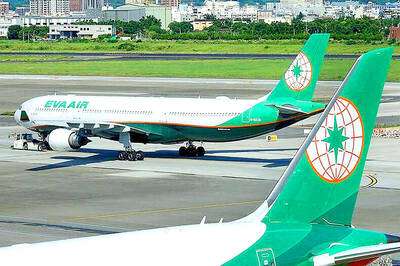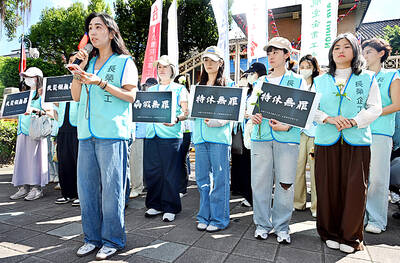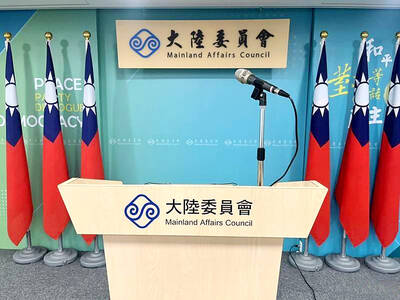The government is offering subsidies to shipping line operators who voluntarily reduce the operating speed of large ships when they enter the nation’s seaports, with each ship receiving NT$8,000 (US$270) for doing so.
The program was introduced to curb emissions of air pollutants as part of the government’s efforts in addressing the deteriorating air quality in the southern Taiwan, the Taiwan International Ports Corp (TIPC) said on Wednesday.
The Kaohsiung-based state-run company said it has been encouraging large vessels to lower their speed to below 12 knots per hour when entering within 20 nautical miles of seaports since 2012.
However, most of them still sail 18 knots per hour, the company said.
Experiences in other countries have shown that ships can reduce their emissions better when they operate at 12 knots per hour or slower, TIPC said.
The budget for the program is NT$32 million this year, including NT$22 million from TIPC and NT$10 million from the Environmental Protection Administration, the company said.
International cruise ships and ships with a cargo capacity of more than 10,000 tonnes entering any of the nation’s international seaports would be subsidized if they meet the standards, it said.
Meanwhile, the Maritime and Ports Bureau has this year set aside a budget of NT$45 million for a trial program to encourage international shipping lines to switch to low-sulfur fuel when they operate close to sea ports.
Each ship that does so will be entitled to a subsidy of NT$5,000.
TIPC estimated that 5,000 tonnes of air pollutants within port zones can be cut through the programs, including 3,832 tonnes of sulfur oxides.
The subsidies would also help curb particulate matter pollution by 21 percent, it said.
Ships are also encouraged to connect to on-shore power supplies when they dock, instead of using their own onboard diesel-powered electricity systems.
The company said that ports are exempt from paying the electricity charge, adding that it is negotiating a discount with the Taiwan Power Co based on its large electricity consumption.

A drunk woman was sexually assaulted inside a crowded concourse of Taipei Railway Station on Thursday last week before a foreign tourist notified police, leading to calls for better education on bystander intervention and review of security infrastructure. The man, surnamed Chiu (邱), was taken into custody on charges of sexual assault, taking advantage of the woman’s condition and public indecency. Police discovered that Chiu was a fugitive with prior convictions for vehicle theft. He has been taken into custody and is to complete his unserved six-month sentence, police said. On Thursday last week, Chiu was seen wearing a white

EVA Airways, one of the leading international carriers in Taiwan, yesterday said that it was investigating reports that a cabin crew manager had ignored the condition of a sick flight attendant, who died on Saturday. The airline made the statement in response to a post circulating on social media that said that the flight attendant on an outbound flight was feeling sick and notified the cabin crew manager. Although the flight attendant grew increasingly ill on the return flight, the manager did not contact Medlink — a system that connects the aircraft to doctors on the ground for treatment advice during medical

The Taoyuan Flight Attendants’ Union yesterday vowed to protest at the EVA Air Marathon on Sunday next week should EVA Airway Corp’s management continue to ignore the union’s petition to change rules on employees’ leave of absence system, after a flight attendant reportedly died after working on a long-haul flight while ill. The case has generated public discussion over whether taking personal or sick leave should affect a worker’s performance review. Several union members yesterday protested at the Legislative Yuan, holding white flowers and placards, while shouting: “Life is priceless; requesting leave is not a crime.” “The union is scheduled to meet with

‘UNITED FRONT’ RHETORIC: China’s TAO also plans to hold weekly, instead of biweekly, news conferences because it wants to control the cross-strait discourse, an expert said China’s plan to expand its single-entry visa-on-arrival service to Taiwanese would be of limited interest to Taiwanese and is a feeble attempt by Chinese administrators to demonstrate that they are doing something, the Mainland Affairs Council said yesterday. China’s Taiwan Affairs Office (TAO) spokesman Chen Binhua (陳斌華) said the program aims to facilitate travel to China for Taiwanese compatriots, regardless of whether they are arriving via direct flights or are entering mainland China through Hong Kong, Macau or other countries, and they would be able to apply for a single-entry visa-on-arrival at all eligible entry points in China. The policy aims